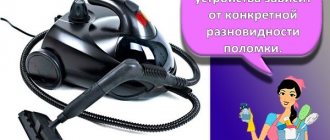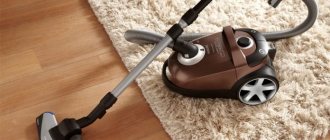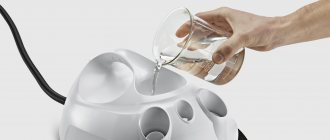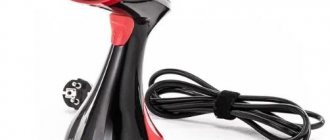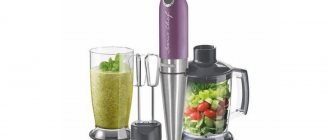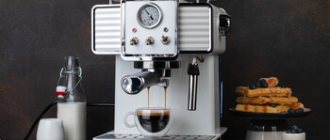Most companies that produce household appliances indicate in their instructions that distilled water cannot be poured into the iron. At the same time, the use of tap water causes scale to form on the heating element due to the salts it contains. Let's figure out why such a ban was introduced, whether there are grounds for it, and how to fill the tank so that the home steamer lasts as long as possible.
How does a steamer work and its types?
According to the design features of steam equipment, manual and vertical steamers differ. In terms of the number of functions - single-function and universal.
Based on the principle of action, there are 2 types:
- gravity flow;
- working under pressure.
Important! Gravity steamers are easier to use, but their power is insufficient, so they cannot smooth thick fabrics.
For devices that operate under pressure, the steam supply intensity is very high. Due to this, hot steam penetrates deeply into any fabric and smoothes it well. A special temperature sensor controls the temperature of the steam that comes from the steamer in cycles.
A vertical steamer can also be used to disinfect various surfaces, toys, etc.
A steam generator is similar in appearance to an iron, but it smoothes fabrics much more effectively. Everything can be treated, from curtains made of delicate fabrics to upholstered furniture and carpets. Has a conditioning effect. This is a very convenient device for maintaining trouser suits, down jackets and fur coats in good condition.
Produces very hot steam. The temperature of the steam, which is released under high pressure, reaches 140 - 160°.
Steam generators are produced in an assortment and are also divided into types:
- manual;
- floor;
- combined.
Interesting! The quality of work depends on the power of the device: the more powerful, the better it copes with the task. The kit may include various attachments that help simplify the use of the device.
Manual steam generators have a number of advantages:
- compact, mobile, lightweight;
- affordable;
- Convenient for frequent use at home and when traveling.
Some cons:
- insufficient power for processing dense fabrics;
- operating time is about 20 minutes.
Floor-standing structures are equipped with large tanks, have high power, but take up a lot of space and are quite expensive.
Combined steamers are similar in functionality: they can be used not only for ironing, but also for cleaning and disinfection. The prices are also high, but they are reliably justified.
Do you have a steam generator?
Not really
Which device should you choose?
Modern industry produces other types of steaming devices:
- steam cleaners – good for cleaning curtains;
- steamers with wet steam;
- functional irons with a steamer (steam generation);
- steam mops.
Advice! Steam generators with hard soles are more suitable for ironing clothes. The greatest effect from ironing is achieved by steam generators that supply 120 - 150 grams of steam per minute to the treatment surface.
When choosing a device, you should focus on well-known brands. Although steamers and steam generators are somewhat different in purpose, both supply steam that is generated from water.
In accordance with the instructions, you can fill the tank with water from the tap. But it doesn’t always differ in quality; not every one is suitable for use. This article will tell you which steam generator is best to choose for your home. Also learn about the design and operating principles of a steam generator.
How to make iron water with your own hands
If you really want your bed linen to have an unusual, refreshing aroma, you can make your own water for the iron at home. To create the liquid you will need:
- 600 g diluted distillate or demineralized water.
- 80 ml of alcohol (you can add vodka).
- 20 – 30 drops of essential oil (lavender, rose, jasmine, cardamom, rosemary, mint, etc. are used).
All ingredients must be thoroughly mixed (preferably in a glass container). Store for one week in a cool, dark place. The flavored liquid can be used for 1 year.
After steaming with an iron, the smell will persist for a long time. Also, once a month you can spray the bed and pillows with homemade water.
The smells of essential oils have a beneficial effect on the human body (eliminate anxiety, insomnia, help with stress, normalize hormonal balance).
Will it work from the tap?
All designs of steam generators have a heating element, which is designed for an average of 10 thousand hours of operation. This is an expensive part that is easily damaged due to scale formation. It is very difficult to replace heating elements, so you need to understand what kind of water is best to pour into the steamer.
Tap water must be discarded due to its high degree of hardness:
- mineral salts and lime form alkaline plaque and scale;
- scale not only clogs the steam holes, but ultimately leads to breakdown of the entire steamer;
- Due to lime, stains may appear on dark-colored fabrics.
There are water softeners, but their use is undesirable:
- promote the formation of chemical compounds;
- clog the device;
- Dirty streaks may appear on the fabric.
Important! Hard tap water must be settled and filtered. After draining the used liquid, you need to descale the device.
Do you use tap water for the steam generator?
Not really
It is allowed to dilute settled tap water by 50% with demineralized liquid. Advantages:
- saving money on purchasing special water;
- protection of the device from scale formation.
Modern manufacturers of ironing products protect them from harshness with filters and self-cleaning systems, but these are expensive models. If the water hardness is high, it is recommended to fill the cartridges with purified liquid.
How to use a clothes steamer correctly
In order to achieve good results when using a steamer, you must adhere to certain rules, namely:
- Direct use must begin only after the device has completely warmed up, which occurs 1-2 minutes after connecting the device to the electrical network;
- The steamer iron must be aimed exactly at the woven surface. When switched on, even in the absence of steam supply, you should not point the sole of the iron at a person, as this can lead to burns;
- the ironing movement should be from top to bottom;
- passing a jet of steam over one place can be repeated if it was not possible to completely smooth the surface the first time.
In addition, there are rules, adhering to which it will be much easier to iron out certain specific things, namely:
- When processing shirts, jackets and dresses, it is best to pull them down a little. It is necessary to place a special board under the collar, in the sleeve or pocket so that the shape of these elements is not lost during the steam treatment process. If this is not possible, then during the ironing process, hold parts of the clothing with a hand wearing a special heat-resistant mitten;
- classic trousers with creases must be hung with the waist down, and the creases themselves must be ironed using a special clip on the iron;
- processing of outerwear must be carried out with the appropriate attachments that come with the steamer, which, in addition to smoothing, will ensure the removal of foreign elements such as hair, fluff and feathers;
- If the design of the iron does not include a heating element and the steam produced is sufficiently humid, then it is impossible to stop the iron in one place for a long time. This will lead to the formation of a wet spot, and subsequently a streak on the fabric;
- Wardrobe items made from thin fabrics such as organza or silk should be ironed with reduced power, while increasing the distance from the surface of the iron to the fabric. In order to predict how a particular fabric will behave when exposed to steam, it is necessary to initially iron the element that is visually hidden.
Why can't you use distilled water?
100% distilled water has a neutral composition, which results in a low boiling point and reduced steam production.
Reduced steam production due to overheating can lead to deterioration of the silicone coating in the evaporation chamber. To increase its boiling point, you need to add regular tap water. If the water is very hard, dilute according to the formula 1:2. The use of such water is allowed only as recommended by the manufacturer.
Attention! You should beware of counterfeits, which contain heavy hydrogen, which destroys the metal parts of steamers.
What kind of water is poured into the steam generator and is preparation necessary?
The quality of water affects both the operation of the device and the steaming results. Before use, it is recommended to check the condition of the device and the water container. If there is some amount of liquid left inside, it is better to drain and refill with fresh liquid.
Steps to prepare the steam generator for operation:
- Study the basic recommendations for the possibility of steam processing of products. Handle nylon and viscose items with care.
- Unscrew the cap, fill the tank, connect to the power source.
- Check the condition of your hands. Hands must be dry.
- Wait for the moment of steam formation.
- Point the iron at the item being steamed and press the operating button.
- Vertical designs process hanging items from top to bottom.
- Items to be ironed with a hard sole are best placed on an ironing board. The iron can be pressed and directed in any direction.
- To prevent the formation of wet spots on things, you need to place a soft cloth under the board cover or use a special perforated board.
- Do not place things with decorative elements on the board.
- To refill water, turn off the network.
- During operation, do not point the device at exposed areas of the hands.
- At the end of ironing, drain the remaining liquid only after it has cooled completely.
Bottled
This type of water, like that from the tap, contains a high content of minerals, which, with frequent use, form deposits and reduce the quality of the ironing and the service life of the steam generator.
Filtered
With high-quality filtration, ordinary water can be used, since the percentage of harmful impurities is reduced.
Demineralized
Deionized water for a steam generator is ideal because, due to the absence of salts, there is no streaking or scale formation. There are no problems with steam formation, the device works for a long time. Dilution with tap water is allowed.
Boiled
Boiling and then cooling ordinary tap water does not improve its quality, since mineral substances are retained and lead to the formation of plaque and scale.
From the well
Borehole and well water are some of the most unsuitable options for a steamer, despite the presence of a filter in the tank. It contains a huge number of chemical compounds. Can be used only after high-quality filtration.
Melted
Water that is formed as a result of melting snow is also not recommended for filling the steamer tank, since it not only contains many chemical compounds, but also dirt. Fabrics and ironing equipment are at risk of damage.
What is a clothes steamer and why is it needed?
A steamer is a device designed to smooth fabric items using a stream of hot air. The main purpose of this household appliance is to steam treat clothing, textiles and other items with a fabric surface to smooth out folds and creases on it. In addition, the increased temperature of the steam ensures disinfection of things, as well as cleaning them from stubborn stains and dirt, eliminating unpleasant odors and destroying mold and dust mites.
The classic version of a steamer for the home is a device whose design includes a steam iron, a telescopic stand with a clothes hanger and a hose for supplying moist air from a steam generator located in a separate plastic housing. The steam generator consists of a water tank and a pump for pumping it up, a heating element and a control panel located on the body. To ensure the connection between the iron and the steam generator, a special hose is used. The iron has holes on its working surface, most often in the amount of at least 6 pieces. To prevent condensation from forming during the steaming process, a heating element can be built into the iron. This type of steamer is called vertical or floor-standing.
There are also simpler and easier to use hand-held steamers. In terms of design, they are similar to floor-standing options with the significant difference that all the main elements of its design are combined in a single body, and there are no hangers for hanging clothes. Such devices are more compact and convenient to use, but they have the disadvantage of low power and a small volume of water tank.
Before choosing a clothing steamer to perform certain specific actions, you need to understand their differences from each other. The main differences include:
- power, which is directly related to the performance of the device. The larger it is, the stronger the steam flow the steamer can produce, which means it can smooth out folds and kinks on thicker fabrics. The optimal power value for household devices is 1800 W. At the same time, if the power is less than 1500 W, then there is no need to count on the fact that such a steamer can iron a coat. These types of devices are more suitable for processing everyday clothes made of thin fabric;
- water tank capacity. This indicator must be selected based on the needs for use and the availability of the necessary space to store the device. The larger the water tank holds, the larger the steam generator housing, but at the same time the frequency of filling is reduced and vice versa. Hand steamers in most cases have a very small water tank, the amount of which is enough for no more than 15 minutes of working with it;
- the presence of a power regulator that allows you to reduce or increase the intensity of steam supply depending on the type of surface being treated. This function is very convenient in everyday life, since the device can be used both for thick curtain fabrics and for dresses and blouses made of thin and delicate fabrics.
Special liquid for irons
The retail chain offers a product that is intended directly for steam generators, steamers and irons.
Pros of use:
- reliable water purification;
- special appointment;
- guarantee that clothes, fabrics and disinfected surfaces are free from stains and stains.
Disadvantages of the product:
- not always available for sale;
- high price;
- the smell of flavored additives can be transferred to things being processed;
- The product may sometimes contain essential oils that form streaks.
Despite some disadvantages, the following are considered the best options:
- special liquid with added flavoring agents;
- distilled with the addition of settled ordinary water, purchased at an official retail outlet;
- demineralized, which also needs to be purchased and diluted;
- filtered tap water.
How much is needed?
Any ironing device: iron, steamer, steam generator - has clear instructions that must be followed.
Ideally, tanks with a volume of up to 1.5 liters are selected for household use. The water heats up within 5 - 7 minutes; The volume of liquid is enough for about half an hour of ironing. If the number of things is large, water must be added.
After finishing work, some liquid may remain in the tank. It is not recommended to leave it for more than 2 - 3 days. It is better to drain the water, rinse the container and dry it.
Important! Monitor the level of liquid that is added to the tank so as not to damage the device. During refueling, scalding steam escapes through the open cap under pressure. Beware of burns.
How to rinse a water container at home?
You can clean the water container at home if you follow the rules.
- Add 1.5 tablespoons of vinegar or citric acid to a glass of water, pour the mixture into the tank.
- Disable the steam function.
- Connect the device to the network and wait a few minutes.
- Turn off the device and drain the liquid.
Types of steam and ironing devices
The first thing that should be mentioned is that it is impossible to put forward a general formula for all steam appliances regarding the use of the type of water: each device has its own technical characteristics and operating requirements.
Thus, the following types of steam appliances are distinguished:
1. Devices whose technical characteristics prohibit the use of distilled water. Due to the absence of impurities such as minerals and salts in distilled water, the distillate boils at a higher temperature than, for example, tap water. Evaporation during the boiling process is a long process, which, in turn, leads to overheating of the elements of steam devices. The second reason for damage to devices when using distilled water is its low electrical conductivity. In particular, the sensors that indicate the volume of water are the first to fail; other elements may also break.
2. Devices whose technical characteristics require the use of only distilled water. As a rule, such devices do not come with cleaning systems and drain holes, which means they require specialist intervention if they break down. In such devices, the use of boiled, filtered, flavored and bottled water is unacceptable, since the minerals and impurities contained in it will have a detrimental effect on the operation of the equipment.
3. Other universal type devices, the technical characteristics of which provide for the use of any water. Such devices must be equipped with a cleaning and filtration system. Ideally, use distillate, but pouring tap, bottled and other water is also allowed, subject to timely, regular cleaning of the device.
How to drain water from a steam generator?
If the next ironing occurs in a day or two, you don’t have to drain the water. Stagnant liquid will lead to damage to the device and things. The water is drained by unscrewing the drain bolt.
The steam generator requires regular maintenance during operation: descaling the iron and cleaning the tank. It is better to clean it every 10 times the steam generator is used. A number of conditions must be met.
- To clean the iron, fill it with water and heat it up as much as possible. Enable cleaning mode. If it is missing, use the steam levers to drain the liquid over the sink.
- To process the tank, unplug the device and cool for two hours.
- Pour 300 ml of water into the removable boiler, shake, and drain into the sink.
- Do not shake the stationary boiler; turn it over a basin or sink several times to drain the water.
- Do not add solvents, including vinegar and descaling agents.
- Washing with running water is not allowed.
Attention! The correct choice of product for filling into the device tank reliably guarantees its long-term uninterrupted operation.
This article will tell you why the steam generator sprays water instead of steam. Read how to use the Tefal steam generator here.
